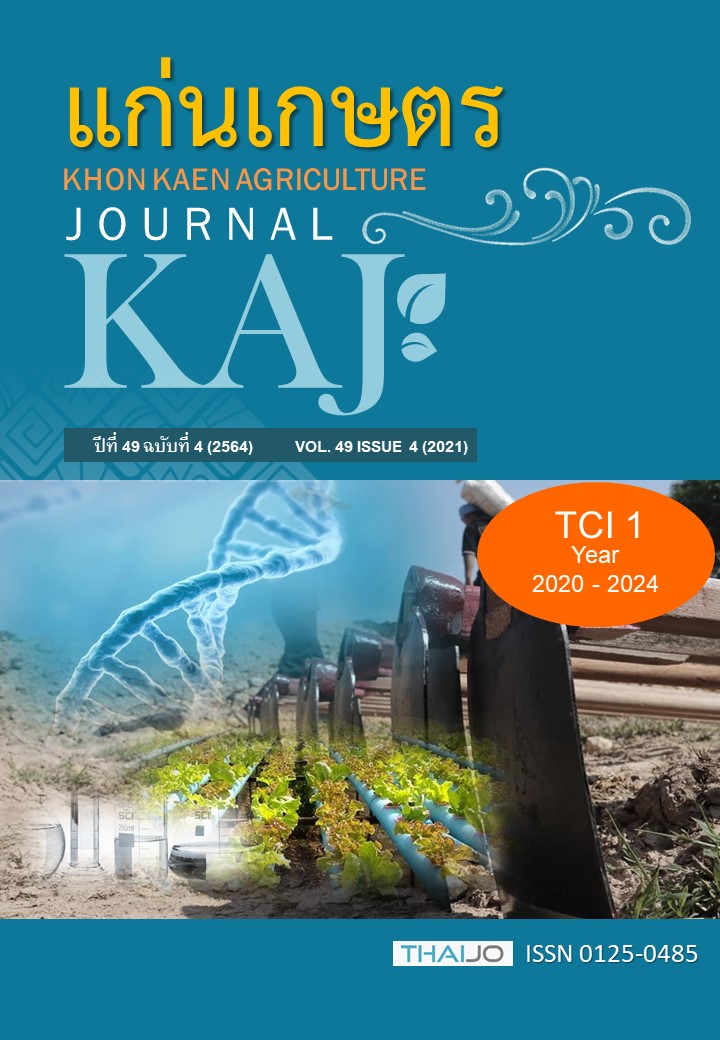การควบคุมโรคเมล็ดพันธุ์มะเขือเทศที่เกิดจากเชื้อรา Fusarium oxysporum f. sp. lycopersici โดยการใช้สารเคมีกำจัดเชื้อรา และเชื้อราปฏิปักษ์
Main Article Content
บทคัดย่อ
การศึกษานี้มีวัตถุประสงค์เพื่อทดสอบการควบคุมโรคเมล็ดพันธุ์มะเขือเทศที่เกิดจากเชื้อรา Fusarium oxysporum f. sp. lycopersici โดยการใช้เชื้อราปฏิปักษ์ 4 ไอโซเลต ได้แก่ Daldinia eschscholtzii ไอโซเลต FL11 และ K12, Trichoderma harzianum ไอโซเลต GR03 และ Trichoderma ghanense ไอโซเลต GR06 และสารเคมีกำจัดเชื้อรา 8 ชนิด ได้แก่ mancozeb, carbendazim, benomyl, prochloraz, propiconazole + difenoconazole, tebuconazole + trifloxystrobin, hymexazol และ fosetyl-aluminium การศึกษาการยับยั้งการเจริญของเส้นใยเชื้อรา F. oxysporum f. sp. lycopersici พบว่า เชื้อราปฏิปักษ์ทั้ง 4 ไอโซเลต สามารถยับยั้งการเจริญของเชื้อราสาเหตุโรคได้เมื่อทดสอบด้วยเทคนิค dual culture assay ในขณะที่สารเคมี mancozeb, carbendazim, benomyl และ prochloraz สามารถยับยั้งการเจริญของเชื้อราสาเหตุโรคได้ 100% เมื่อทดสอบด้วยเทคนิค poisoned food การทดสอบประสิทธิภาพการควบคุมโรคในสภาพห้องปฏิบัติการและเรือนทดลองพบว่าการแช่เมล็ดมะเขือเทศที่ปลูกเชื้อราสาเหตุโรคด้วยเชื้อราปฏิปักษ์ Daldinia eschscholtzii FL11 และสารเคมี mancozeb, carbendazim และ benomyl สามารถลดอัตราการเกิดโรคและความรุนแรงของโรคได้ นอกจากนี้ยังไม่มีผลกระทบต่ออัตราการงอกของเมล็ด และการเจริญเติบโตของต้นกล้ามะเขือเทศ
Article Details

อนุญาตภายใต้เงื่อนไข Creative Commons Attribution-NonCommercial-NoDerivatives 4.0 International License.
เอกสารอ้างอิง
กานต์ จิตสุวรรณรักษ์ และ อนันต์ วงเจริญ. 2559. ผลของเชื้อราเอนโดไฟต์ต่อการควบคุมโรคไหม้ของข้าว (Oryza sativa L.). แก่นเกษตร.44(ฉบับพิเศษ 1): 232-23.
กานต์ จิตสุวรรณรักษ์ และ อนันต์ วงเจริญ. 2560. ประสิทธิภาพของราเอนโดไฟต์และสารเคมีต่อการยับยั้งเชื้อราสาเหตุโรคข้าว (Oryzae sativa L.). ใน: การประชุมวิชาการอารักขาพืชแห่งชาติ ครั้งที่ 13 วันที่ 21 – 23 พฤศจิกายน 2560.
ทักษิณา ผุดผาด ชุตินันท์ ชูสาย และ อนันต์ วงเจริญ. 2559ก. การควบคุมโรคใบจุดนูนและใบจุดก้างปลาของกล้ายางพารา (Hevea brasiliensis Müll. Arg.) โดยชีววิธีด้วยการใช้เชื้อ Trichoderma spp. แก่นเกษตร. 44(ฉบับพิเศษ 1): 225-231.
ทักษิณา ผุดผาด ชุตินันท์ ชูสาย และ อนันต์ วงเจริญ. 2559ข. ประสิทธิภาพของสารเคมีและเชื้อราเอนโดไฟต์ Trichoderma spp. ต่อการยับยั้งเชื้อราสาเหตุโรคของยางพารา (Hevea brasiliensis Müll. Arg). แก่นเกษตร. 44(ฉบับพิเศษ 1): 953-959.
วราภรณ์ บุญเกิด จีรนันท์ แหนมสูงเนิน และ นัฐธิภรณ์ เดชบุรัมย์. 2560. การควบคุมโรคเหี่ยวเหลืองของมะเขือเทศด้วยสารป้องกันกำจัดโรคพืชและจุลินทรีย์ปฏิปักษ์ในสภาพเรือนทดลอง. ใน: การประชุมวิชาการ ครั้งที่ 55 มหาวิทยาลัยเกษตรศาสตร์ วันที่ 31 มกราคม – 3 กุมภาพันธ์ 2560.
สำนักควบคุมพืชและวัสดุการเกษตร. 2563. ปริมาณและมูลค่าการส่งออกเมล็ดพันธุ์ควบคุม. 2562. แหล่งข้อมูล: http://www.doa.go.th/ard/?page_id=1443 ค้นเมื่อ 1 พฤศจิกายน 2563.
อนันต์ วงเจริญ. 2557. การคัดเลือกเชื้อราเอนโดไฟต์จากข้าว (Oryza sativa L.) ที่มีประสิทธิภาพยับยั้งราสาเหตุโรคข้าว. แก่นเกษตร. 42(3): 385-396.
อนันต์ วงเจริญ ประหยัด ปิยะนันทพงศ์ อลงกรณ์ สุริโย และพชรมน เล็บสิงห์. 2562. ประสิทธิภาพของเชื้อ Daldinia eschscholtzii ในการควบคมโรคเหี่ยวของมะเขือเทศที่เกิดจากเชื้อ Fusarium oxysporum f.sp. lycopersici. แก่นเกษตร. 48(ฉบับพิเศษ1): 1181-1188.
Agrios, G. N. 1988. Plant Pathology. Academic Press, Inc. New York.
Akhtar, T., Q. Shakeel, G. Sarwar, S. Muhammad, Y. Iftikhar, M. I. Ullah, M. Mubeen, and A. Hannan. 2017. Evaluation of fungicides and biopesticides for the control of Fusarium wilt of tomato. Pakistan Journal of Botany. 49: 769-774.
Aroosa, K., A. Dliferoze, Z. U. Malik, A. Shoaib, and S. Khurshid. 2012. In vitro chemical control of Fusarium oxysporum f.sp. Lycopersici. Mycopathologia. 10: 57-61.
Brown, S., S. T. Koike, O. E. Ochoa, F. Laemmlen, and R. W. Michelmore, 2004. Insensitivity to the fungicide fosetyl-aluminum in California isolates of the lettuce downy mildew pathogen, Bremia lactucae. Plant Disease. 88: 502-508.
Debbi, A., H. Boureghda, E. Monte, and R. Hermosa. 2018. Distribution and genetic variability of Fusarium oxysporum associated with tomato diseases in Algeria and a biocontrol strategy with indigenous Trichoderma spp. Frontiers in Microbiology. 9: 282.
Devi, R., T. Kaur, D. Kour, K. L. Rana, A. Yadav, and A. N. Yadav. 2020. Beneficial fungal communities from different habitats and their roles in plant growth promotion and soil health. Microbial Biosystems. 5: 21-47.
Elad, Y., and A. Kapat. 1999. The role of Trichoderma harzianum protease in the biocontrol of Botrytis cinerea. European Journal of Plant Pathology. 105: 177-189.
Fuchs, J. G., Y. Moënne-Loccoz, and G. Défago. 1999. Ability of nonpathogenic Fusarium oxysporum Fo47 to protect tomato against Fusarium wilt. Biological Control. 14: 105-110.
Görtz, A., E. C. Oerke, T. Puhl, and U. Steiner. 2012. Effect of environmental conditions on plant growth regulator activity of fungicidal seed treatments of barley. Journal of Applied Botany and Food Quality. 82: 60-68.
Gullino, M. L., F. Tinivella, A. Garibaldi, G. M. Kemmitt, L. Bacci, and B. Sheppard. 2010. Mancozeb: past, present, and future. Plant Disease. 94: 076-1087.
Kim, J., and J. D. Kim. 2008. Inhibitory effect of algal extracts on mycelial growth of the tomato-wilt pathogen, Fusarium oxysporum f. sp. lycopersici. Mycobiology. 36: 242-248.
McQuilken, M.P. and J. Gemmell, 2004. Enzyme production by the mycoparasite Verticillium biguttatum against Rhizoctonia solani. Mycopathologia. 157: 201-205.
Ramezani, H. 2009. Efficacy of fungal and bacterial bioagents against Fusarium oxysporum f.sp. ciceri on chickpea. Plant Protection Journal. 1: 108-113.
Roncero, M. I. G., C. Hera, M. Ruiz-Rubio, F. I. G. Maceira, M. P. Madrid, Z. Caracuel, F. Calero, J. D. Jarana, R. R. Rodriguez, A. L. M. Rocha, C. Velasco, J. Roa, M. M. Urdiroz, D. Co´rdoba, and A. D. Pietro. 2003. Fusarium as a model for studying virulence in soilborne plant pathogens. Physiological and Molecular Plant Pathology. 62: 87-98.
Rodriguez, R., J. Jr. White, A. Arnold, and R. Redman. 2009. Fungal endophytes: Diversity and functional roles. New Phytologist. 182: 314-330.
Sahar, P., S. T. Sahi, A. Jabbar, A. Rehman, K. Riaz, and A. Hannan. 2013. Chemical and biological management of Fusarium oxysporum f. sp melongenae. Pakistan Journal of Phytopathology. 25: 155-159.
Sivakumar, T., P. Balabaskar, and K. Sanjeevkumar. 2018. Variability in Fusarium oxysporum f. sp. lycopersici causing wilt of tomato. International Journal of Chemical Studies. 6: 3655-3659.
Sreeja, K., M. Anandaraj, and R. S. Bhai. 2019. Colonization and plant growth promotion in somatic embryo derived black pepper plants by fungal endophytes. Journal of Global Biosciences. 8: 6525-6539.
Srivastava, R., A. U. S. Singh, and A. K. Sharma, 2010. Evaluation of arbuscular mycorrhizal fungus, fluorescent Pseudomonas and Trichoderma harzianum formulation against Fusarium oxysporum f. sp. lycopersici for the management of tomato wilt. Biological Control. 53: 24-31.
Song, W., L. Zhou, C. Yang, X. Cao, L. Zhang, and X. Liu. 2004. Tomato Fusarium wilt and its chemical control strategies in a hydroponic system. Crop Protection. 23: 243-247.
Sundaramoorthy, S., and P. Balabaskar. 2013. Biocontrol efficacy of Trichoderma spp. against wilt of tomato caused by Fusarium oxysporum f. sp. lycopersici. Journal of Applied Biology and Biotechnology. 1: 36-40.
Taskeen, U. N., W. A. Bhat, M. Y. Pala, S. A. and R. A. Mir. 2011. In vitro inhibitory effect of fungicides and botanicals on mycelial growth and spore germination of Fusarium oxysporum. Journal of Biopesticides. 4: 53-56.


